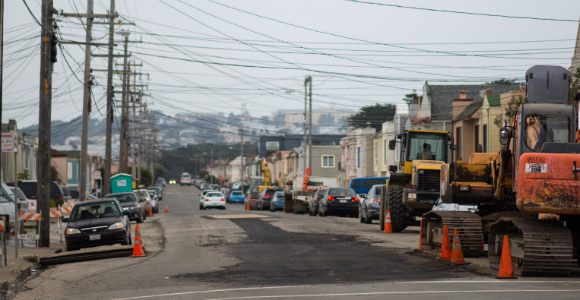
Road work in San Francisco. (Photo Credit: Daniel Hoherd/Flickr)
After years of seeking more authority to make much-needed investments in local infrastructure and economic development projects, California’s local governments were handed a robust new financing tool by the Legislature last week when lawmakers approved Senator Jim Beall’s SB 628, a bill that expands the authority of an existing investment mechanism known as Infrastructure Financing Districts.
The bill’s “enhanced” IFDs (EIFDs) were approved by the Assembly 43-30, with the Senate voting 21-13 on concurrence. The legislation, which first appeared in the governor’s January budget proposal and was supported throughout the year by leaders of the Summit’s Infrastructure Action Team, now awaits the governor’s signature.
“This bill will help local jurisdictions finance transportation projects and transit-oriented development,’’ Senator Beall (D-San Jose) said when the legislation passed, noting enormous funding gaps local leaders face as they try to make investments in everything from aging water mains and crumbling local roads to next-generation transit stations. The City of Los Angeles alone, for example, is estimated to have a backlog of $8.1 billion in deferred infrastructure maintenance—a figure as large as the city’s entire annual budget.
With state resources constrained and no sign of increased federal support for infrastructure investment, SB 628’s new authority will finally give local governments a way to pool their resources—and tap into the tax increment financing tools they had under redevelopment—to do something about it.
“With the option of creating Enhanced Infrastructure Financing Districts…communities can create transit-oriented neighborhoods and business districts to cut traffic gridlock, reduce commutes and greenhouse gas emissions,” Beall said. “These investments not only ensure the health and well-being of our communities but they will also serve to create jobs.’’
The Summit’s views on EIFDs
After supporting these ideas throughout the year, the Summit has released a white paper—A How-to Guide for Using SB 628’s Enhanced Infrastructure Financing Districts—that details how local and regional agencies could use this new authority to invest in everything from sidewalk repair and water infrastructure to the implementation of sustainable communities plans. The Summit also plans to convene local leaders in several different regions this fall to help create pipeline of projects that could benefit from creating an EIFD.
“These enhanced financing districts would give communities more authority to build the infrastructure California needs to achieve its growth and sustainability goals,” says Mark Pisano, a senior fellow at USC’s Price School of Public Policy who coauthored the Summit report.
“These financing districts would not only be able to build all public infrastructure, they could also serve as a platform for multiple funding streams—and provide a foundation for the types of public-private partnerships that we know can be so successful in developing infrastructure,” says Sean Randolph, president and CEO of the Bay Area Council Economic Institute, who serves as co-lead of the Infrastructure action team. “The new districts can also do a lot to encourage the types of policy integration we’ll have to see to successfully implement regional sustainable communities strategies.”
The impact on housing
In the final days of the legislative session, some housing advocates expressed concern about how much these new authorities could impact affordable housing—calling for more specific set-asides for housing akin to those under redevelopment and for clearer language to ensure new financing districts don’t contribute to gentrification and displacement. Mindful of these provisions, Brian Augusta, a legislative advocate with the Western Center on Law and Poverty, has called the final bill “half a loaf.”
Summit leaders continue to call for a dedicated, statewide source of funding for affordable housing—a top priority of the Summit’s housing action team—and have also joined housing advocates’ calls for a cleanup bill next year to deal with some of these provisions.
“This bill moved quickly last week and there wasn’t adequate time to amend it before the deadline of the 2013-14 legislation session,” says Fred Silva, senior fiscal advisor at California Forward, who staffs the Summit’s Infrastructure Action Team. “The bill offers a strong new financing mechanism for local infrastructure, including affordable housing. There are some areas where the language needs to be clearer about housing, particularly as it relates to the responsibility of a district for replacing housing when a project will have an impact on existing residential units.”
Sen. Beall has said he is open to introducing a clean-up bill next year, as well as broadening public participation in the project development process.
In the meantime, whether a public agency is interested in upgrading sidewalks and streets for stormwater collection or expanding transit stations, the legislation’s new authorities could support local infrastructure in a way no other financing mechanism currently does.
With the governor’s signature, those tools can be in the hands of local governments as soon as next year—finally giving communities a way to take on one of California’s preeminent fiscal challenges.

